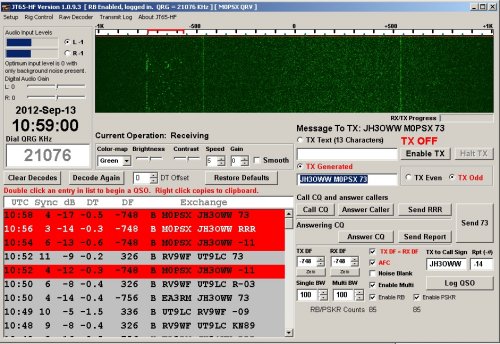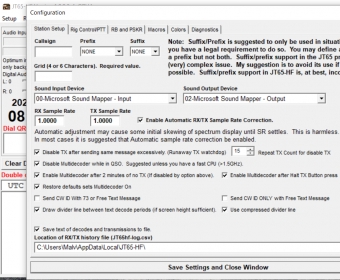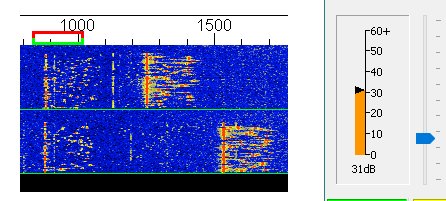

I’ve always said I was only at my very best podcasting about amateur radio when I was active and involved. But before PARP ever returns, I need to get engaged back into the hobby. While it has been 14+ months since I released an episode, the site still gets a lot of traffic and I occasionally still receive emails asking what is going on. Regarding my podcast ( The Practical Amateur Radio Podcast), I really don’t want it to just fade away. My intention is to enjoy the hobby and see where things lead me. I’m not sure just how active I will be in the coming weeks or months. It was a good feeling answering my first CQ in almost a year.
Jt65 hf frequency software#
After syncing my PC clock (it was some 4+ minutes off) I fired up HRD, launched the JT65-HF software and the waterfall began filling up. My Yaesu FT-897 was parked on 14.076 (right where I had left it almost a year ago) and much to my surprise everything still worked.

Jt65 hf frequency free#
However, one thing I did mention in that posting was amateur radio was by no means the cause of my grief, it (among a few other things) just reminded me of it.Īnyway, last night I had a bit of free time and decided to go down to my basement ham shack and switch on the computers, switch on the radios and see what was happening on the bands. I’m not going to go rehash that as you can read that posting here. I provided (or tried to provide) an explanation to my long absence both on the bands, the blogosphere and the podcast airwaves. The last time I updated my blog site was soon after the first of the year. For higher frequencies, where the natural noise generally becomes less and less, and frequency stability becomes more and more of a challenge, JT65 is more suitable.This will be a very brief blog update. So for MF and HF, where you want to be heard over the QRN and frequency stability isn't a big problem, JT9 works great. That makes them approximately 1.5x, 3x, and 6x as forgiving to drift as JT9. JT65A has a tone spacing of 2.7Hz, JT65B 5.4Hz, and JT65C 10.8Hz.

As the frequency goes up, it becomes borderline impossible. But to receive a message using an FSK mode where the tones are only separated by 1.75Hz, the transmitter and the receiver had both better be stable to better than 1Hz. Given the first argument, you might think that JT9 is always going to be the best choice for a low-data-rate, high-sensitivity mode. If we can make a signal narrower, and the receiver filter narrower, while keeping the same signal power, the amount of noise goes down proportionally and the SNR goes up proportionally. The power of the natural noise we receive is proportional to the width of our passband in Hz. Why does this matter and how does it relate to which one you would use on which band? JT65A (the mode commonly used in HF) is 180Hz wide, JT65B (often used for 2m EME) is 360Hz wide, and JT65C (often used for 33cm and up) is 720Hz wide. In the vast majority of cases, this simplifies to a rule of thumb of "use JT65 for VHF and up, and JT9 on HF".īoth modes are FSK, and both have the same effective data rate (72 data bits in about 50 seconds), but there is one very big difference between them: bandwidth. So it would appear not to be so much JT65 being preferred for VHF, as JT65 being better suited for line of sight links and JT9 being optimized for ionospheric propagation links. On the other hand, JT65 probably achieves a higher data transmission rate but would seem to put higher requirements on the stability of the received signal strength, as one would see on VHF and up where the major propagation mode is line of sight (with a reflector thrown in for good measure in e.g. Similar to how CTCSS tones can make it through noise so well.

According to Wikipedia, JT65 uses 65-tone MFSK (Multiple Frequency-Shift Keying), whereas JT9 uses 9-tone FSK (Frequency-Shift Keying) probably hence the numerals in the respective names.īy only ever transmitting exactly one out of a set of fewer tones, it would appear intuitively that JT9 would be better suited to the variable signal strength commonly found in ionospheric propagation there are fewer possibilities, and on the receiver side you only need to identify the one tone that is currently being transmitted.


 0 kommentar(er)
0 kommentar(er)
